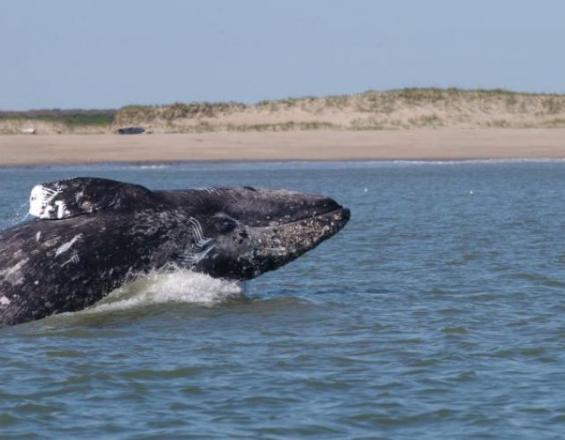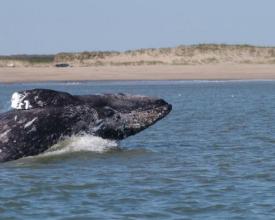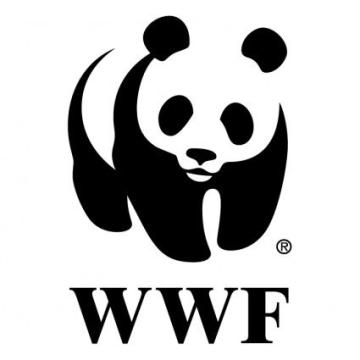
Los datos científicos guían la actuación de la industria en la conservación de las ballenas

A medida que el mundo avanza hacia un futuro más sostenible, los líderes empresariales y gubernamentales se enfrentan a retos sobre cómo conciliar conservación y desarrollo.
Los Grupos Asesores Independientes, Científicos y Técnicos (ISTAP) dirigidos por la UICN están ayudando a abordar cuestiones complejas y a menudo polémicas relativas al uso de los recursos naturales. Ofrecen asesoramiento científico imparcial para reducir los impactos de un proyecto sobre la naturaleza e identificar soluciones que puedan contribuir a la conservación y al mismo tiempo cumplir los objetivos económicos y de desarrollo.
El primer ISTAP que se creó fue el Grupo Asesor sobre la Ballena Gris Occidental (WGWAP), en 2004. El WGWAP asesora de forma independiente a Sakhalin Energy sobre cómo minimizar los riesgos asociados a sus operaciones sobre la ballena gris y su hábitat, al tiempo que colabora con otros agentes para garantizar la conservación de la ballena a largo plazo. Las zonas de alimentación de las ballenas cerca de la isla de Sajalín, frente a la costa rusa -una región con grandes yacimientos de petróleo y gas en alta mar- son vitales para mantener la población.
Contexto
Défis à relever
Al igual que con todos los paneles independientes de la UICN, existen riesgos y desafíos inherentes que requieren una vigilancia continua. Estos incluyen el riesgo para la reputación por estar asociado con la prestación de asesoramiento sobre esquemas de alto impacto que involucran al sector privado o grandes actividades de desarrollo.
La colaboración entre las empresas, el sector público y la sociedad civil puede poner de relieve las diferencias en la forma en que las instituciones abordan determinados retos. Por lo tanto, el desarrollo de relaciones y la creación de confianza entre estas instituciones son fundamentales. Por ejemplo, las empresas y el mundo académico pueden tener ideas diferentes sobre el tiempo y los recursos necesarios para la recopilación de datos, la consulta, la toma de decisiones y el seguimiento.
Otros riesgos incluyen la flexibilidad de la empresa o agencia gubernamental contratante para cambiar sus prioridades en función de cualquier prueba con base científica, así como el presupuesto y el tiempo necesarios para que el panel elabore conclusiones y recomendaciones.
Ubicación
Procesar
Resumen del proceso
Todos los atributos clave de los paneles científicos de la UICN se han conjugado en el caso del WGWAP para garantizar una base sólida para crear confianza y relaciones entre un amplio grupo de interesados, algunos de los cuales han estado enfrentados durante años. Lleva tiempo llegar a un entendimiento común sobre temas controvertidos y un camino a seguir, pero el WGWAP ha construido un impulso constante a lo largo de los años para alcanzar la influencia en áreas y sectores más allá de la ambición original.
Bloques de construcción
Independencia
Existe una estructura que garantiza que el panel esté libre de cualquier influencia externa, ya sea del gobierno, del sector privado, de ONG, de científicos o de la UICN. Los miembros del grupo son libres de llegar a lo que consideren las mejores conclusiones y recomendaciones basadas en los últimos conocimientos científicos disponibles. Pueden expresar libremente sus opiniones y no tienen ningún acuerdo contractual de financiación de la investigación ni de otro tipo con la parte financiadora/contratante ni con ninguna otra empresa que opere en la plataforma de Sajalín (incluidas sus empresas matrices o filiales).
Factores facilitadores
El ámbito de trabajo del panel se basa en una serie de cuestiones específicas y predefinidas sobre conservación y gestión de recursos naturales. Los miembros aportan los conocimientos necesarios desde distintas disciplinas y perspectivas, y se espera que consideren todas las pruebas que se les presentan desde un punto de vista estrictamente técnico o científico.
Lección aprendida
La independencia del WGWAP es fundamental para que pueda cumplir la función para la que fue creado, y la UICN ayuda a salvaguardar la integridad del panel. En algunas ocasiones, por ejemplo, el panel ha emitido declaraciones públicas de preocupación, cuando lo ha considerado necesario.
Transparencia
La transparencia es fundamental para generar confianza entre todas las partes interesadas. La información y documentación sobre el proceso del panel, sus modalidades de trabajo, informes, conclusiones y recomendaciones, así como las respuestas de las empresas, se ponen a disposición del público en el sitio web de la UICN, sin alteraciones. También se publican los nombres, biografías y términos de referencia de los miembros del panel.
Factores facilitadores
Las funciones y responsabilidades de todos los participantes en el grupo, así como su supervisión, se definieron claramente desde el principio, incluidos los distintos interesados de la UICN y la parte contratante.
A las reuniones del WGWAP asisten representantes de las empresas, contratistas técnicos, científicos, representantes de los prestamistas, así como observadores de ONG, gobiernos, otras empresas, institutos de investigación locales y otros, todos los cuales pueden hacer preguntas y aportar datos e información.
Lección aprendida
Todas las medidas adoptadas para garantizar la independencia y transparencia del panel han generado confianza entre las partes interesadas y credibilidad en las operaciones y conclusiones del panel.
Por ejemplo, como parte del Plan de Monitoreo y Mitigación (MMP) de la empresa, un observador independiente, contratado por la UICN, estuvo presente durante los estudios sísmicos de 2010, 2015 y 2018 para elaborar un informe de primera mano sobre la aplicación del MMP y proporcionar recomendaciones para mejoras en el futuro. El observador asiste al panel y a la empresa en la evaluación de la eficacia de los esfuerzos de mitigación, proporcionando información útil al GTAP y, en última instancia, a la empresa. Sakhalin Energy es la única empresa energética que opera en Sajalín que permite la presencia de un observador independiente como parte de su programa de vigilancia y mitigación de los estudios sísmicos, y esto se debe en parte a la colaboración a largo plazo con el WGWAP.
Rendición de cuentas
Como ocurre con todos los ISTAP, se han tomado medidas para garantizar que el WGWAP tenga un objetivo claro, ofrezca resultados de alta calidad a tiempo y se gestione de forma coherente con las políticas y procedimientos de la UICN. Una estructura de gestión del proyecto define el papel y las responsabilidades del director del proyecto y de otros miembros del personal o unidades de la UICN. El presidente del panel es responsable de la gestión de los miembros del panel, que informan sobre cuestiones científicas y técnicas. Todos los miembros del panel, incluido el presidente, dependen de la UICN y tienen su propio mandato.
Existe un sistema de supervisión periódica para verificar que el panel funciona de plena conformidad con los principios de la ISTAP, que ofrece los resultados acordados según los términos de referencia y el plan de trabajo, y que se siguen el plan de participación de las partes interesadas y la estrategia de comunicación. Sobre la base del plan de trabajo, el gestor del proyecto elabora presupuestos anuales que, si así lo exige el contrato, se presentan a la parte contratante para su aprobación.
Factores facilitadores
Los ISTAP se apoyan en un mecanismo de reclamación para garantizar que las quejas recibidas se atienden de la manera más transparente, justa y oportuna.
El director del proyecto trabaja con el equipo de seguimiento y evaluación de la UICN para verificar la integridad del proceso del panel y sus resultados, así como para evaluar las repercusiones generales del panel y el potencial de una mayor asimilación de sus recomendaciones.
Lección aprendida
Mediante el establecimiento de un sistema de seguimiento y evaluación, la UICN ha podido salvaguardar la rendición de cuentas tanto del panel como de la empresa. Por ejemplo, en el lanzamiento del informe Historias de influencia del GTAP en 2016, se informó de que de las más de 539 recomendaciones del panel a Sakhalin Energy y otras partes, el 90% se habían aplicado o sustituido por asesoramiento posterior.
Compromiso
El grupo trabaja con todas las partes interesadas y afectadas, como la Comisión Ballenera Internacional (CBI), gobiernos locales y federales, empresas, contratistas, pesquerías, operadores turísticos, ONG, prestamistas, instituciones financieras e institutos de investigación. Cuenta con una amplia red de expertos a todos los niveles y recibe pruebas de diversas disciplinas y perspectivas.
A lo largo de los años, el panel ha contribuido a aliviar las tensiones entre los distintos grupos de interés creando un foro abierto de diálogo, sobre todo entre las ONG y Sakhalin Energy. Las organizaciones que hicieron campaña contra la financiación de la empresa participan ahora como observadoras en las reuniones del GTAP.
El WGWAP ha contribuido a aumentar el número de foros en los que se debate la conservación de las ballenas, con la creación de nuevos foros regionales y nacionales en la Federación Rusa. Se han forjado estrechas relaciones entre el WGWAP y la CBI, lo que favorece una visión más amplia de los problemas de la ballena gris. Varios Estados del área de distribución también han adoptado un Memorando de Cooperación sobre Medidas de Conservación para la ballena gris occidental que hace referencia al Plan de Gestión de la Conservación de la CBI/UICN (actualmente en revisión), a la CBI y al WGWAP.
Factores facilitadores
Los vínculos y la capacidad del grupo para relacionarse con un abanico tan diverso de partes interesadas se han forjado a lo largo de varios años. Generar confianza requiere tiempo, voluntad de aceptar pruebas y escuchar los puntos de vista de los demás, y valor para mantener debates difíciles.
Lección aprendida
Una lección clave aprendida a través de la participación del panel ha sido la importancia de comprender y navegar por las diferencias culturales, ya sean corporativas o institucionales, peculiaridades de nacionalidad, idioma o terminología utilizada para describir retos y soluciones.
Además, aunque el panel se centra principalmente en Sakhalin Energy, también ha demostrado las ventajas de adoptar un enfoque más holístico de la conservación de las ballenas y explorar sinergias y aportaciones a los procesos nacionales y de toda la zona de distribución. Esto implicaría trabajar más estrechamente con los sectores de la pesca, la navegación y el turismo, que también afectan a las ballenas, y abordar los impactos acumulativos. Es necesario que las partes interesadas sigan debatiendo para determinar si el panel es el modelo más eficaz para asumir un alcance significativamente mayor.
Aproveche
La exposición internacional y la atención prestada a las ballenas grises occidentales gracias al trabajo del WGWAP han catalizado otros foros de debate en los que ONG, científicos y empresarios pueden intercambiar información. El Gobierno ruso se dirigió al grupo en busca de orientación para integrar la biodiversidad en el desarrollo y ha creado varias estructuras oficiales, entre ellas un grupo de trabajo interdepartamental sobre la conservación de la ballena gris.
En cuanto a la legislación y el cumplimiento, el grupo desearía que todos los gobiernos establecieran unas condiciones equitativas para las empresas que operan en hábitats marinos clave o en zonas adyacentes, a fin de garantizar que la conservación sea un requisito más amplio y no sólo un requisito para los prestamistas.
Factores facilitadores
El WGWAP se creó a raíz de una condición impuesta en el acuerdo de préstamo de Sakhalin Energy, según la cual la empresa debía trabajar con un grupo de expertos independientes y asesorarse por ellos. Esto demuestra que las instituciones financieras pueden desempeñar un papel importante en la conservación y que cada vez se interesan más por el comportamiento social y medioambiental de la industria a través de mecanismos como las normas de sostenibilidad de la Corporación Financiera Internacional (CFI).
Lección aprendida
El proceso del GTAP aprovechó los conocimientos y la experiencia de los expertos para ayudar a salvaguardar las ballenas grises de Sajalín, al tiempo que aportó importantes lecciones a otras partes interesadas. Sakhalin Energy también ha aprovechado las recomendaciones del grupo para aplicar las mejores prácticas, por ejemplo en prospecciones sísmicas y prevención de vertidos de petróleo, lo que a su vez le ha ayudado a posicionarse mejor en el sector y a promover la conservación a escala mundial.
Impactos
- En 2005, Sakhalin Energy modificó el trazado de su oleoducto después de que el GTAP recomendara una alternativa que minimizara el impacto en las zonas de alimentación de las ballenas.
- El Grupo de Trabajo sobre Vertidos de Petróleo del WGWAP ayudó a desarrollar una respuesta corporativa a los vertidos de petróleo, considerada una de las mejores del sector.
- Sakhalin Energy pospuso un año su gran prospección sísmica en 2009, siguiendo el consejo del WGWAP, y trabajó con el grupo en uno de los planes más completos de seguimiento y mitigación a nivel de empresa en relación con la conservación de las ballenas y las prospecciones sísmicas.
- En la actualidad, profesionales de todo el mundo utilizan directrices para realizar prospecciones sísmicas eficaces y responsables con el medio ambiente, centradas en la protección de las ballenas y otras especies marinas, que han servido de base para las políticas de Estados Unidos, Nueva Zelanda y el Convenio sobre la Diversidad Biológica.
- La experiencia del WGWAP tiene un gran potencial para influir en futuros desarrollos en otras regiones petrolíferas y gasísticas con importantes retos de conservación, como el Ártico. También está orientando a otras ISTAP en cuestiones controvertidas de conservación y desarrollo.
- Las conclusiones del WGWAP han contribuido a la Comisión Ballenera Internacional, así como al debate sobre la conservación en la Federación Rusa y fuera de ella.
Beneficiarios
- Ballena gris occidental
- Energía Sakhalin
- ONG
- UICN
- Comunidad científica
Objetivos de Desarrollo Sostenible
Historia
A principios de la década de 2000, crecía la preocupación por el posible impacto de las operaciones de petróleo y gas en una pequeña población de ballenas grises occidentales en peligro crítico que se alimentaba cada verano y otoño frente a la isla rusa de Sajalín, en el mar de Okhotsk. Cuando una de las principales empresas, Sakhalin Energy, buscó financiación para ampliar sus operaciones, las protestas públicas alcanzaron un crescendo y se impuso una condición sin precedentes en el acuerdo de préstamo, que exigía a la empresa el asesoramiento de un grupo independiente de científicos.
En 2004, se pidió a la UICN que convocara lo que hoy se conoce como el Grupo Asesor sobre la Ballena Gris Occidental (WGWAP). Más de una década después, el panel sigue proporcionando asesoramiento objetivo e independiente a la empresa y a otros actores sobre la conservación de estas ballenas y su hábitat.
Una de las primeras medidas acordadas en 2005 fue que Sakhalin Energy modificara el trazado de un oleoducto después de que el panel recomendara una ruta alternativa para minimizar la perturbación de las zonas de alimentación de las ballenas. Desde entonces, el WGWAP ha contribuido a la elaboración de orientaciones técnicas y al desarrollo de buenas prácticas en toda una serie de cuestiones, desde planes corporativos de respuesta a vertidos de petróleo hasta planes de vigilancia y mitigación de prospecciones sísmicas. También ha servido de plataforma para la colaboración científica con gobiernos, la Comisión Ballenera Internacional y la sociedad civil.
Es importante destacar que durante este tiempo, gracias a los esfuerzos colectivos, la población de ballenas grises occidentales ha aumentado entre un 3 y un 4% anual, pasando de unos 115 animales en 2004 a 174 en 2015. Sin embargo, el grupo ha advertido de que es necesario seguir trabajando para implicar a otros operadores de petróleo y gas de la región, así como a otros sectores como la pesca y el turismo, para garantizar la protección a largo plazo de las ballenas.
El WGWAP ha demostrado que los paneles independientes con base científica pueden convertir ámbitos de conflicto potencial en espacios de cooperación e incluso colaboración, y ayudar a las empresas de cualquier sector a reducir su impacto en zonas ecológicamente sensibles o en especies vulnerables.

